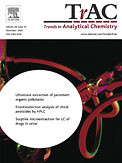Adam V, Fabrik I, Kizek R, Adam V, Eckschlager T, Stiborová M, Trnková L. Trends in Anal. Chem., Vol. 29, Issue 5, May 2010, Pages 409–418. IF: 5.485

Abstract:
Metallothioneins (MTs) are a family of ubiquitous, biologically interesting proteins that have been isolated and studied in a wide variety of organisms, including prokaryotes, plants, invertebrates and vertebrates. Due to the property of MTs being metal-inducible and their high affinity to metal ions, homeostasis of heavy-metal levels is probably their most important biological function. MTs are also involved in other important biochemical pathways, including scavenging of reactive oxygen species, activation of transcription factors and participation in carcinogenesis. Detection and quantification of MTs are not simple due to the unique primary structure and their relatively low molecular mass. Analytical methods are based on: a) detection of bound metal ion; b) detection of free -SH groups; c) protein mobility in electrical field; and, d) interaction with different types of sorbent. This review highlights techniques used for detection and determination of MTs with discussion of the advantages and the disadvantages of particular approaches.
-az-